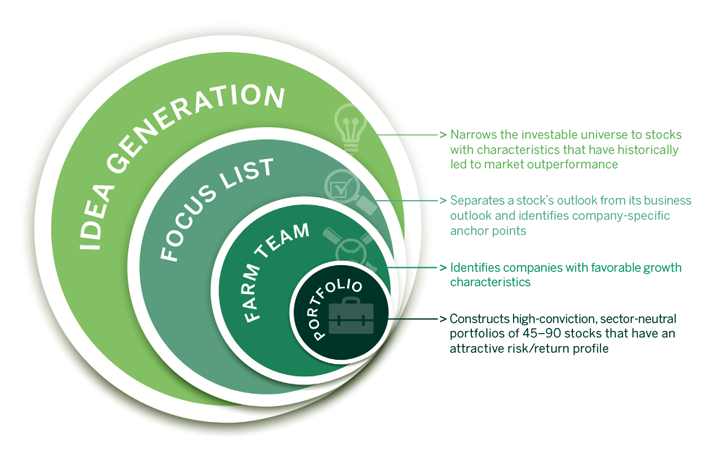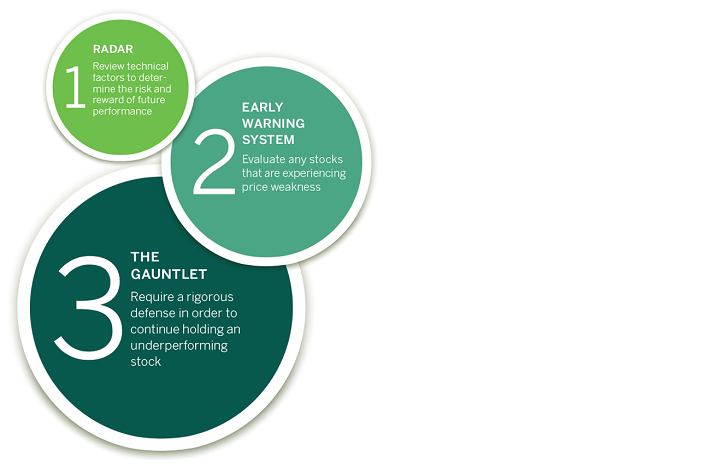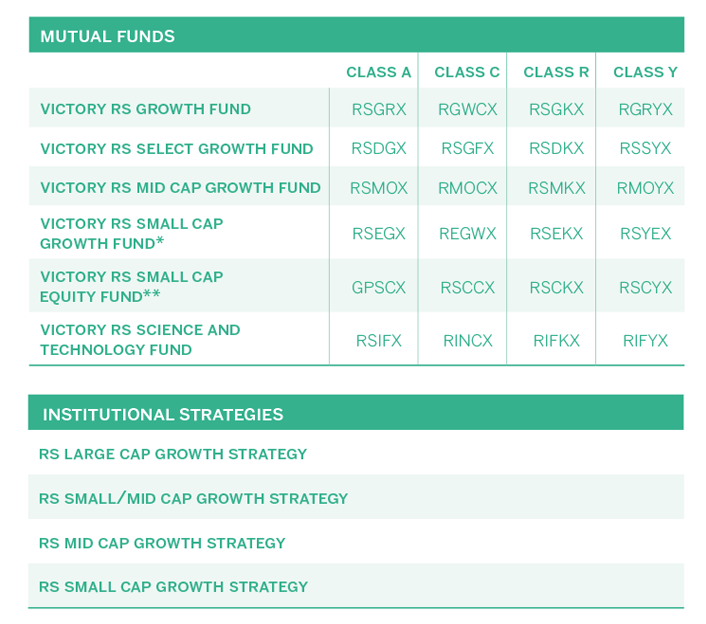*There is no guarantee that any portfolio will achieve its objective.
**RS Growth portfolios are available as mutual funds and separate account strategies
Idea Generation
Sector specialists discover new stock ideas from both internal and external sources, supported by quantitative and fundamental techniques. Qualitative sources include analyst industry knowledge gained from 2,000 company meetings each year, primary research, industry conferences, and a deep sell-side analyst network. Quantitative screens help identify attractive stocks that meet five key criteria demonstrated to be essential characteristics of strong growth stocks:
Growth sustainability—Focus on companies that the team believes can deliver double-digit growth over three to five years.
Company quality—Seek out good businesses with high return on equity, high and improving margins, and low debt.
Attractive relative valuation—A good company on the Farm Team and a good stock in the portfolio is differentiated by how it is priced.
Positive earnings estimate revisions— The company has a track record of earnings that have exceeded analyst expectations.
Favorable relative strength—The stock’s recent price trend reflects the company’s strong fundamentals. The team then scores the applicable universe based on these five factors and performs rigorous fundamental research on companies within the top two quintiles
The team then scores the applicable universe based on these five factors and performs rigorous fundamental research on companies within the top two quintiles.
Focus List
Fundamental research—deep, company-specific analysis focused on long-term business prospects—separates a company’s stock outlook from its business outlook.
This research seeks to gain an information edge by identifying anchor points for each company. Anchor points are business drivers that mark a company’s expected growth trajectory and facilitate a longer-term investor’s view.
The most attractive companies offer identifiable anchor points that provide the team with the conviction to hold a stock through periods of heightened volatility.
This process narrows the universe of attractive stocks to a more manageable Farm Team.
What are Anchor Point?
Analyst-defined business anchor points are drivers and milestones a company is expected to reach and typically:
Tie the team's investment thesis to each company's three-to-five-year earnings projections, which helps facilitate a longer-term view.
Give the team continued conviction to hold a stock through periods of heightened volatility.
Farm Team
Portfolio managers then rank each of these companies based on the analysts’ valuation estimates of upside potential return versus downside risk. The upside price target is based on a fair multiple of the analyst’s estimate of earnings for the upcoming calendar year. The downside estimate is based on a more conservative multiple of the company’s last 12 months of earnings.
Portfolio
Portfolio managers look to build sector-neutral portfolios with relatively narrow allocation bands (typically between plus-or-minus 20% of benchmark weights) with the goal of driving excess performance primarily through stock selection.
This investment process aims to take advantage of market inefficiencies by building growth portfolios with high active share.
By applying this process consistently, the team believes it can capture most of the upside of positive market returns while avoiding some of the downside of negative markets. Their objective, of course, is to pursue strong absolute and risk-adjusted returns over full business cycles. As with all investments, there is no guarantee that a fund will achieve its objective.
"We look to identify companies that can parlay their innovative ideas into sustainable earnings growth."
Risk Management and Sell Discipline - Know the Risks
For the RS Growth Team, the path to returns is just as important as the returns themselves, so they’ve devoted considerable attention to building and refining their risk management framework.
Risk management isn’t a separate discipline— it’s integrated throughout the investment process. It begins with the analyst’s estimate of upside potential versus downside risk and continues with weekly meetings where the team continually scrutinizes individual securities. A three-part risk management protocol then helps minimize the potential negative impact of any individual position.
1. Radar
The Radar helps maintain the team’s objectivity about each holding. Most important, it helps ensure that a holding’s hard-won gains aren’t lost.
Designed to flag potential issues with a company’s fundamentals before they are well known, the Radar may give the team an advance warning of potential problems.
It utilizes quantitative analysis of technical factors—such as breaking a moving average; increase or decrease in the stock’s volatility; or performance that differs materially from sector peers—that may foreshadow a stock’s future negative developments. The team then further analyzes each stock to understand the causes of its behavior to determine whether to sell, hold or add to a position.
2. Early Warning System
The Early Warning System examines the previous month’s 10 best- and worst-performing holdings, aiming to catch underperforming stocks before they have a material impact on portfolio performance.
At this stage, portfolio managers and analysts will assess whether a stock’s price weakness reflects serious issues with the business, or whether it represents a temporary blip in performance.
Depending on the results, the team may continue to hold the stock, add to a position, or sell it.
3. The Gauntlet
Stocks on the Gauntlet have scored poorly within the team’s quantitative ranking system as well as exhibited price weakness that has likely detracted materially from portfolio performance. To reach the Gauntlet, a stock has likely had one or more negative developments—within the business itself or in the marketplace— that have caused its weakness.
For these reasons, the team places limits on these holdings—generally, stocks on the Gauntlet can represent no more than 10% of the total portfolio while an individual analyst’s holdings are limited to 2% of the total portfolio. These stocks are subjected to a comprehensive review in which the entire team scrutinizes the investment thesis to ensure objectivity.
Continued ownership requires a full defense that includes analysis of reasons to own, anchor points, valuation, and a re-examination of its upside/downside ratio. Above all, the team must have a clear rationale for how they expect the stock to leave the Gauntlet and outperform going forward.
Most of the time, the team will sell stocks that have reached the Gauntlet but periodically they will defend and continue to hold stocks with positive outlooks.








